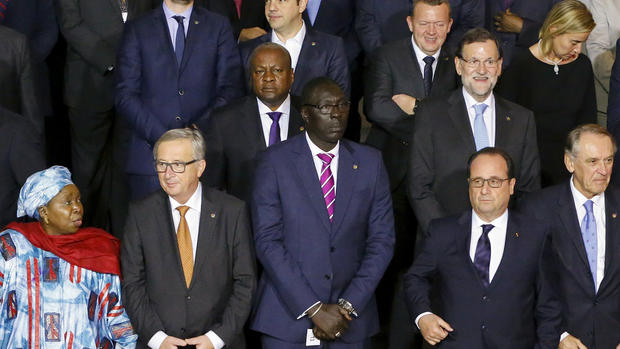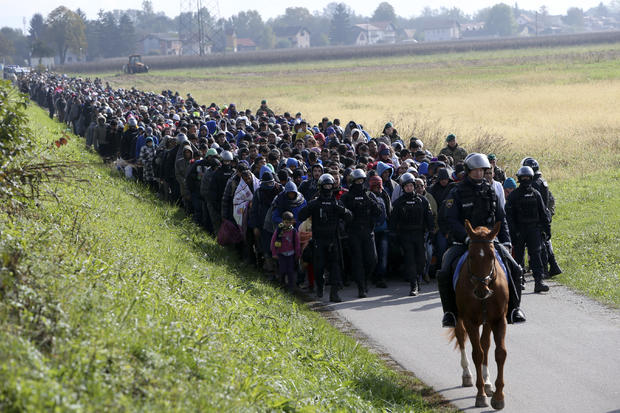EU asks African leaders to take back some migrants
VALLETTA, Malta - The European Union pressed African leaders on Wednesday to take back thousands of people who do not qualify for asylum, holding talks in Malta as overwhelmed Slovenia began building a razor-wire border fence to keep asylum-seekers out.
In Sweden, the interior minister said the government would introduce temporary border controls on Thursday to stem the flow of migrants to the Scandinavian country.
According to the International Organization for Migration, almost 800,000 people have entered Europe by sea this year. The EU predicts that three million more could arrive by 2017.
The Europeans say most Africans are coming in search of work and should be sent home, but many deliberately arrive without documents and must wait months before they are taken back.
In the latest draft of an "Action Plan" to be made public after the summit, the African leaders would commit "to cooperate with the EU on return and admission, notably on travel documentation."
A controversial plan for African migrants to be issued with EU documents that would speed their extradition was dropped. Migration experts had criticized the plan, saying it shortchanged peoples' asylum rights.
The president of Niger - a major transit route for Africans heading to lawless Libya in the hopes of crossing the Mediterranean to Europe - was cautious about opening the floodgates to returns.
"We are open to talk about it. Everything will depend on the conditions that will be put in place for when they arrive," he told reporters at the summit in Valletta, adding that the best method of solving Europe's migration crisis is to attack the root causes forcing people to leave in the first place.
"We can put security measures in place, but the flow will remain difficult to stop as long as we don't take measures to reduce poverty," he said.
The EU is working closely with Niger to stem the flow of migrants toward Libya, and ultimately with Europe. It is also trying to seal deals with Morocco, Tunisia and Egypt at the two-day summit.
The bloc also renewed calls for member countries to contribute hundreds of millions of euros to a fund to help African nations better manage migration given the tepid response so far.
The European Commission has put 1.8 billion euros ($1.9 billion) into the "trust fund" and wants EU nations to match that figure.
In Slovenia, army trucks carrying fencing and bulldozers arrived in Veliki Obrez on Wednesday and soldiers began unwinding the spirals of wire and stretching them along the Slovenian side of the Sutla River that divides the country from Croatia. Other units were later seen with fencing further southwest, near the town of Gibina.
Tensions later mounted on the Slovenia-Croatia border, with Croatian authorities saying parts of the fence were being put up in disputed territory. AP journalists saw Croatian police demand that Slovenia take down a section of the fence.
Croatian special forces arrived at the Harmica border crossing, while Slovenian special police with long barrel weapons stood on the Slovenian side. A helicopter flew above illuminating the area with a spotlight before the Croatian forces pulled back.
Croatia authorities claim that the Slovenian fence has entered Croatian territory in seven locations and want it removed.
Slovenia denies any part of the fence is on Croatian soil. Both countries are locked in a dispute over certain parts of their territory after the breakup of Yugoslavia in the 1990s.
Earlier, Slovenian Foreign Minister Karl Erjavec informed Austrian authorities in Vienna that the razor-wire fence would be 50 miles long, according to the Austrian Press Agency.
Slovenian Prime Minister Miro Cerar said his country expects about 30,000 new migrants to reach its borders. His government fears that if neighboring Austria restricts their entry, the thousands stranded in Slovenia would be too much for the tiny Alpine state to handle.
"If we don't act on time," Cerar said, "this could cause a humanitarian catastrophe on the territory of Slovenia."
He said the barrier will be used to direct the refugee flow, not to close the 400-mile border, as was the case in Hungary when it put up border fences.
Nearly 170,000 migrants have crossed into Slovenia since mid-October, when Hungary closed its border with Croatia and the flow of desperate people heading to Western Europe was redirected to Slovenia.
In Sweden, Interior Minister Anders Ygeman said the border controls will be introduced at 1100 GMT (6 a.m. EST) on Thursday and last until Nov. 21.
Sweden says migration authorities are overstretched and nearly 200,000 asylum-seekers are expected this year. Relative to population size - Sweden has 9.7 million people - no other EU country comes close.
It wasn't immediately clear whether the move would allow Sweden to turn people away at the border. But it would hinder people from transiting through the country to reach neighboring Finland and Norway.
Migrants arriving at the border would have to decide whether to apply for asylum in Sweden or to turn back around, Ygeman said. Most migrants are coming to Sweden by boat from Germany or across the Oresund bridge from Denmark.
He said the move was a way to "bring order" to the Swedish asylum system while sending a signal to the EU.
"Our signal to the EU is crystal clear: Sweden is the country that has taken the greatest responsibility for the refugee crisis," he said. "The other countries have to take their responsibility."
In other developments, 14 migrants, including seven children, drowned early Wednesday when their boat sank off the coast of Turkey, the state-run news agency reported. Divers were searching for more possible victims.

